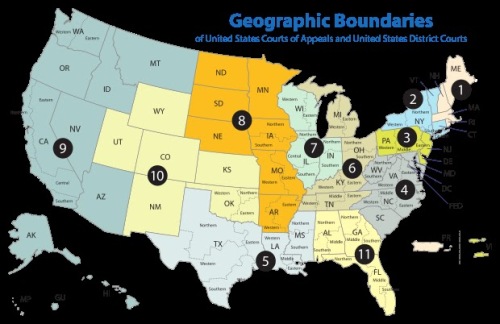
The first year of the Biden Administration has drawn to a close. As a former Senate Judiciary Committee Chair, President Biden could be said to have been particularly attuned to the importance of judicial nominations, and this bears out in the numbers. This Administration has outpaced other recent Administrations in both nominations and confirmations (all numbers are drawn from the Federal Judicial Center).
Nominations
In the first year of his presidency, Biden submitted 73 nominees to Article III courts, more than any other modern president. Comparatively, President Trump submitted 69 judicial nominations in his first year, President Obama submitted 34, President George W. Bush submitted 61, President Clinton submitted 47, President George H.W. Bush submitted 23, and President Reagan submitted 44. Biden has particularly outpaced other Presidents on District Court nominees, having submitted 55, more than any other President.
Comparatively, the 18 appellate nominees submitted by Biden are slightly lower than both Trump (19) and W. Bush (25). However, this can be explained by the number of vacancies each of the prior presidents inherited. President W. Bush inherited 26 appellate vacancies, while President Trump inherited 17. In comparison, President Biden inherited only two vacancies, making his pace even more impressive.
Confirmations
In 2021, the Senate confirmed 40 Article III judges: 11 judges to the U.S. Court of Appeals; and 29 judges to the U.S. District Court. This outpaces every President since Reagan who saw 41 judges confirmed (one Supreme Court, 8 appellate, and 32 district). In terms of appellate confirmations, Biden’s 11 falls short only of Trump’s 12.
Furthermore, Biden saw confirmation of 55% of judicial nominees submitted in his first year. This marks the first significant uptick in first year confirmation percentage in modern history, as this has been dropping since Reagan. To compare: please see the percentages of other Presidents below:

Percentage of Nominees Confirmed in 1st Year of Presidency
Withdrawals
Additionally, President Biden has, despite having to navigate a 50-50 Senate, not seen a single judicial nominee defeated or blocked yet. In comparison, the Trump Administration had lost three nominees in their first year: Jeff Mateer; Matthew Petersen; and Brett Talley. This record is largely due to the caucus willing to stick together on judicial nominees. Not a single Biden judge has attracted any Democratic opposition.
President Biden’s success on nominations is despite the nominees having drawn more GOP opposition than the nominees of any previous President. Out of the 11 appellate nominees confirmed, only one attracted more than four votes from across the aisle (Tiffany Cunningham) and four attracted no minority votes at all (Eunice Lee, Myrna Perez, Lucy Koh, and Jennifer Sung). In comparison, despite drawing more opposition than any prior president, President Trump had more than four votes across the aisle for three nominees (Kevin Newsom, Ralph Erickson, and Joan Larsen).
Diversity
The Biden Administration has prioritized choosing women and racial/ethnic minorities for court seats, seeking to do so to offset the lack of diversity in the nominees of previous administrations. They have also sought out nominees from backgrounds that are traditionally less likely to become judges, including public defenders, and civil rights attorneys. Both focuses are reflected in the nominees put forward.
So far, Biden has nominated thirteen women to the court of appeals, and a whopping forty-one women on the district level, making 74% of his judicial nominations women. In comparison, 23% of Trump’s judicial nominees in his first year were women, 38% of Obama’s judicial nominees from his first year were women, as were 25% of George W. Bush’s, 37.5% of Clinton’s, 17% of George H.W. Bush’s, & 5% of Reagan’s.
Biden’s confirmations has surged the number of women on the U.S. Court of Appeals from 59 to 64, moving the court of appeals from 33.3% female to 36.6% female.
Furthermore, approximately three out of four Biden nominees are lawyers of color, compared to less than 10% of President Trump’s first year nominees.
Age
Biden’s judicial nominees have been compared to those of President Trump in terms of their youth, but, as noted earlier, President Trump’s nominees, at least in his first year, were not significantly younger than those of previous presidents, with an average age of 49.5 for appellate nominees and 52.5 for district court nominees. So far, President Biden’s appellate nominees have an average age of 48.7, while his district court nominees have an average age of 49.8, making them slightly younger than those of previous presidents, but not significantly so.
Overall Assessment
Looking at the empirical evidence, it is clear the Biden Administration has moved quickly on nominations, submitting more judges to the senate than any other recent president. They have also prioritized confirmations, moving judges through the process faster than prior presidents. Nonetheless, this success must come with the caveat that Biden is the first President since Carter to have a Senate controlled by his party by the end of his first year, while also avoiding a Supreme Court confirmation. Overall, while gaps remain, the Biden Administration’s success on judges reinforces the significance of the tenuous 50-seat majority that Senate Democrats hold, and the significant influence of each senator in maintaining that majority.


